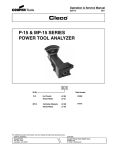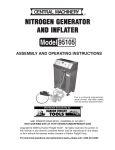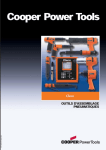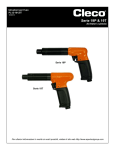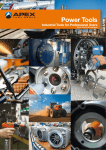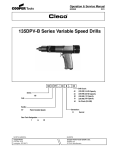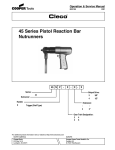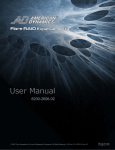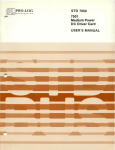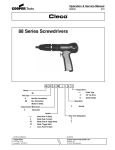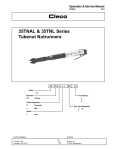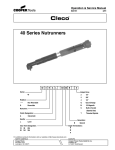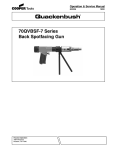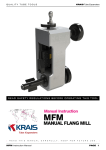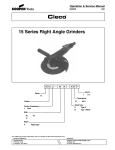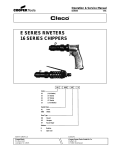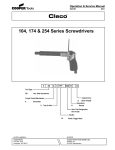Download 45 Series Inline Reaction Bar Nutrunners
Transcript
Operation & Service Manual 823110 2/01 45 Series Inline Reaction Bar Nutrunners 45 X N X X - X - Series: X Output Drive: 3 3/8" 4 1/2" 45 Rotation: R Non Reversible Reversible Nutrunner: Clutch Designation: A Clecomatic J Joint Rate Stall Type Handle: B L Button Lever Gear Train Designation: 2 4 3 6 NORTH AMERICA EUROPE CooperTools P.O. Box 1410 Lexington, SC 29071 Cooper Power Tools GmbH & Co. Postfach 30 D-73461 Westhausen 1 Safety Recommendations For your safety and the safety of others, read and understand the safety recommendations and operating instructions before operating a nutrunner. by the tool. Tool balance arms are also available to absorb the torque reaction of the tool while balancing the weight of the tool for improved ergonomic applications. Always wear protective equipment: ! ! WARNING Impact resistant eye protection must be worn while operating or working near this tool. For additional information on eye protection and face protection, refer to Federal OSHA Regulations, 29 Code of Federal Regulations, Section 1910.133., Eye and Face Protection, and American National Standards Institute, ANSI Z87.1, Occupational and Educational Eye and Face Protection. Z87.1 is available from the American National Standards Institute, Inc., 11 West 42nd Street, New York, NY 10036. ! If the tool is to be reversed, locate torque reaction bar in a position that will resist torque reaction and prevent entrapment. See Directions on next page. Tools with clutches can stall rather than shut-off if adjusted over maximum power output of tool, or if there is a drop in air pressure. Reaction bar must be properly positioned to resist torque. Operator must release throttle to stop tool if this occurs. Do not use without properly positioned reaction bar. Reversible tools can have torque reactions in either direction. The reaction bar must be properly positioned to resist the torque reaction. CAUTION Personal hearing protection is recommended when operating or working near this tool. Hearing protection is recommended in high noise areas 85 dBA or greater. The operation of other tools and equipment in the area, reflective surfaces, process noises and resonant structures can substantially contribute to, and increase the noise level in the area. Excessive air pressure 90PSIG or worn motor components can also increase sound level emitted by tool. For additional information on hearing protection, refer to Federal Regulations, Section 1910.95, Occupational Noise Exposure, and American National Standards Institute, ANSI S12.6, Hearing Protectors. Cleco nutrunners are designed to operate on 90 psig (6.2 bar) maximum air pressure. If the tool is properly sized and applied, higher air pressure is unnecessary. Excessive air pressure increases the loads and stresses on the tool parts, sockets, and fasteners and may result in breakage. Installation of a filterregulator-lubricator in the air supply line ahead of the tool is recommended. Before the tool is connected to the air supply, check the throttle for proper operation (i.e., throttle moves freely and returns to closed position). Clear the air hose of accumulated dust and moisture. Be careful not to endanger adjacent personnel. Before removing a tool from service or changing sockets, make sure the air line is shut off and drained of air. This will prevent the tool from operating if the throttle is accidently engaged. It is essential for safe operation that any operator of a nutrunner use good balance, sure footing, and proper posture in anticipation of a torque reaction. Insure that the operator's hand will not be wedged or pinched between the work and the tool when operating. Reaction bar nutrunners are equipped with a torque reaction bar. These bars can be braced against the work or other suitable points to absorb and relieve the operator of the torque reaction transmitted 2 CAUTION ! WARNING Repetitive work motions and/or vibration may cause injury to hands and arms. Use minimum hand grip force consistent with proper control and safe operation. Keep body and hands warm and dry. Avoid anything that inhibits blood circulation. Avoid continuous vibration exposure. Keep wrists straight. Avoid repeated bending of wrists and hands. Some individuals may be susceptible to disorders of the hands and arms when performing tasks consisting of highly repetitive motions and/or exposure to extended vibration. Cumulative trauma disorders such as carpal tunnel syndrome and tendonitis may be caused or aggravated by repetitious, forceful exertions of the hands and arms. Vibration may contribute to a condition called Raynaud's Syndrome. These disorders develop gradually over periods of weeks, months, and years. It is presently unknown to what extent exposure to vibrations or repetitive motions may contribute to the disorders. Hereditary factors, vasculatory or circulatory problems, exposure to cold and dampness, diet, smoking and work practices are thought to contribute to the conditions. Any tool operator should be aware of the following warning signs and symptoms so that a problem can be addressed before it becomes a debilitating injury. Any user suffering prolonged symptoms of tingling, numbness, blanching of fingers, clumsiness or weakened grip, nocturnal pain in the hand, or any other disorder of the shoulders, arms, wrists, or fingers is advised to consult a physician. If it is determined that the symptoms are job related or aggravated by movements and postures dictated by the job design, it may be necessary for the employer to take steps to prevent further occurrences. These steps might include, but are not limited to, repositioning the workpiece or redesigning the workstation, reassigning workers to other jobs, rotating jobs, changing work pace, and/or changing the type of tool used so as to minimize stress on the operator. Some tasks may require more than one type of tool to obtain the optimum operator/tool/task relationship. Safety Recommendations The following suggestions will help reduce or moderate the effects of repetitive work motions and/or extended vibration exposure: • Use a minimum hand grip force consistent with proper control and safe operation • Keep body and hands warm and dry (cold weather is reported to be a major factor contributing to Raynaud's Syndrome) • Avoid anything that inhibits blood circulation —Smoking Tobacco (another contributing factor) —Cold Temperatures —Certain Drugs Avoid OK Extension Neutral Avoid Flexion Avoid Neutral Ulnar Deviation • Tasks should be performed in such a manner that the wrists are maintained in a neutral position, which is not flexed, hyperextended, or turned side to side. • Stressful postures should be avoided — select a tool appropriate for the job and work location • Avoid highly repetitive movements of hands and wrists, and continuous vibration exposure (after each period of operation, exercise to increase blood circulation) • Keep tool well maintained and replace worn parts For more information on the safe use of portable air tools, see the latest edition of ANSI B186.1, Safety Code for Portable Air Tools, available from the American National Standards Institute, Inc. 11 West 42nd Street, New York, NY 10036. This information is a compilation of general safety practices obtained from various sources available at the date of production. However, our company does not represent that every acceptable safety practice is offered herein, or that abnormal or unusual circumstances may not warrant or require additional procedures. Your work may require additional specific safety procedures. Follow these procedures as required by your company. WARNING OVERLOADED REACTION BARS MAY BEND OR BREAK! USE THIS GUIDE FOR PROPER APPLICATION OF THE CLECO REACTION BAR. Standard Length Spindle X = 2 1/2" Minimum Y = 2 1/2" Maximum Torque Capacity = 125 Ft. Lbs. Maximum 3" Longer Than Standard Spindle X = 4" Minimum Y = 5 1/2" Maximum Torque Capacity = 80 Ft. Lbs. Maximum Avoid OK Radial Deviation ! These capacities apply to Cleco Reaction Bars code numbers: 869769-0, 869770-8, 202007-1, 202008-9, 202009-7. ! WARNING Substitute bars without proper metallurgy may not be adequate. Use Cleco reaction bars. Due to the multitude and variety of tooling applications involving reaction bar nutrunners,the "User's" Methods Engineering, Standard Tooling Engineering, and/or Safety Engineering Departments , etc. , must consider any hazards associated with each specific application of this product and provide adequate operator protection, reaction points and strengths, and operator training in the safe use of this product. 203185 203289 WARNING ! OVER Repetitive work motions and/or vibration can cause injury to hands and arms. Use minimum hand grip force consistent with proper control and safe operation. Keep body and hands warm and dry. Avoid anything that inhibits blood circulation. Avoid continuous vibration exposure. Keep wrists straight. Avoid repeated bending of wrists and hands. CAUTION WARNING Personal hearing protection is recommended when operating or working near this tool. ! ! Impact resistant eye protection must be worn while operating or working near this tool. Hearing protection is recommended in high noise areas (above 85 dBA). Close proximity of other tools, reflective surfaces, process noises, and resonant structures can substantially contribute to the sound level experienced by the user. 203185-4 Read Operating Instructions carefully. Follow the Safety Recommendations for your safety and the safety of others. READ OPERATING INSTRUCTIONS Do not remove this tag until the operator of this tool has read these safety precautions. Warning Labels The warning labels found on these tools are an essential part of this product. Labels should not be removed. Labels should be checked periodically for legibility. Replace warning labels when missing or when the information can no longer be read. Replacement labels can be ordered as any spare part. The reaction bar is secured to the tool and braced against the work in the opposite direction of spindle rotation. This will transfer the torque reaction from the tool to the work. 3 OPERATING INSTRUCTIONS 45 STALL-TYPE NUTRUNNERS The 45 stall-type nutrunner is designed to develop maximum rated torque at 90 psig. Torque output is controlled by a pressure regulator in the air supply line. Adjust the regulator until the desired torque is reached. 45 CLECOMATIC NUTRUNNERS The 45 Clecomatic nutrunner is designed to operate on 90 psig maximum air pressure but does not depend on controlled air pressure to maintain accurate torque. Accurate torque is achieved by setting the Clecomatic clutch to the desired torque on the application. The tool will shut off automatically at this torque. Releasing the throttle will allow the tool to reset for the next cycle. ! If the clutch is adjusted over the maximum CAUTION power output of the tool, the clutch will not function and the tool will operate like a stall-type tool. Also, if the tool is being operated at its upper torque limits, a drop in air pressure could cause the clutch not to function due to a loss of motor power and the tool will function like a stall-type tool. If the tool stalls the operator must release throttle to stop tool. Reaction bar must be properly positioned against adequate stop. Do not use without reaction bar. CLECOMATIC CLUTCH ADJUSTMENT Depress the pin, No. 864711, and rotate the adjustment cover, No. 867677, 180 ° so it lines up with the adjustment slot. With the angle head end of the tool facing outward, away from the operator, use a 1/8" diameter pin to rotate the adjustment nut, No. 867678, clockwise to increase the torque and counterclockwise to decrease the torque. Note: The steel ball, No. 844077, is a positive lock for the adjustment nut and must be in place in a locking slot before the adjusting cover is rotated to the locked position after each clutch adjustment is completed. 45 JOINT RATE NUTRUNNERS The 45 joint rate tool is designed to give repeatable torque and automatic shut off, regardless of the joint conditions (i.e. soft pull, hard pull). Target torque is achieved through the use of an in-line pressure regulator. Note: To ensure automatic shut off, the air pressure should not be adjusted below 40 psig at the tool, with the tool operating. AIR SUPPLY For maximum performance, use a 3/8" I.D. air hose no longer than 8' in length. If additional length is required, a 1/2" or larger hose should be connected to the 3/8" hose. The air hose should be cleared of accumulated dirt and moisture, then one (1) teaspoon of 10W machine oil should be poured into the tool's air inlet before connecting the hose to the tool. 4 LUBRICATION An automatic in-line filter-lubricator is recommended as it increases tool life and keeps the tool in sustained operation. The in-line lubricator should be regularly checked and filled with a good grade of 10W machine oil. Proper adjustment of the inline lubricator is performed by placing a sheet of paper next to the exhaust ports and holding the throttle open approximately 30 seconds. The lubricator is properly set when a light stain of oil collects on the paper. Excessive amounts of oil should be avoided. Application of the tool should govern how frequently it is greased. It is recommended that the idler gears receive a generous amount of NLGI 2-EP grease through the grease fittings after 40 hours of operation. STORAGE In the event that it becomes necessary to store the tool for an extended period of time (overnight, weekend, etc.), it should receive a generous amount of lubrication at that time and again when returned to service. The tool should be stored in a clean and dry environment. SERVICE INSTRUCTIONS DISASSEMBLY — GENERAL Stall Tools To disassemble the tool, clamp the motor housing lightly in a soft-jawed vise with the tool in a vertical position. Using a suitable wrench, loosen and remove the gear case. Using a soft-faced mallet, tap the front of the motor housing to remove the motor unit. Automatic Shut-Off Tools To disassemble the tool, clamp the flats of the clutch housing in a soft-jawed vise and loosen the gear case. Clamp motor housing in the vise and using a suitable wrench, loosen the clutch housing from the motor housing. Tap the front of the motor housing with a soft-faced mallet to remove the motor unit. SUBASSEMBLY DISASSEMBLY Gear Train The complete gear train may be slipped out of the rear of the gear case. By driving the idler gear pins out of the rear of the spiders, the idler gears can be removed from the spider pockets. Clecomatic Clutch Remove the adjustment cover by sliding it off the back of the clutch housing. Be careful not to lose the steel ball, No. 844077, that will drop out at this time. Using the slots provided on the rear face of the adjusting nut, No. 867678, unscrew it from the clutch housing. The torque spring bearing, No. 867683; spring plate, No. 867669; and torque spring, No. 867665, will come out through the rear of the clutch housing. With a soft mallet, tap on the gear end of the clutch to remove it from the clutch housing. By removing the retainer ring, No. 847022; the drive shaft washer, No. 867666; trip sleeve spring, No. 202056; trip sleeve, No. 867670; and two (2) steel balls, No. 842161, can be removed from the drive shaft. Remove the clutch cam bearing, No. 619377, with a suitable puller. Using a sharp instrument, remove the spiral ring, No. 865436. This will allow the clutch cam, No. 867676; three (3) steel balls, No. 842161; trip plunger spring, No. 867671; and trip plunger, No. 867668, to be removed through the front of the drive shaft. To remove the six (6) steel balls, No. 844265, slide the ball retainer, No. 867673, off over the rear of the drive shaft. Motor Unit Clamp the cylinder lightly in the vise with the gear end of the rotor up. Note: The rotor pinion, No. 867524, used on the -4 and -6 models should be removed at this time. Drive the rotor out of the front rotor bearing, No. 619377. Be careful not to damage the rotor. The front bearing plate, No. 869054, cylinder, and rotor blades, No. 869575, can now be removed from the rotor. Clamp the body of the rotor in the vise with the rear bearing plate up. After unscrewing the bearing lock nut, No. 865352, the rotor can be driven out of the rear rotor bearing. Motor Housing — Lever Unscrewing the throttle valve cap, No. 864531, will allow removal of the throttle valve for inspection of the throttle valve seal, No. 847366. Drive out the throttle lever pin, No. 847808, for removal of the throttle lever, No. 847505. The exhaust deflector, No. 869736, and muffler, No. 202743, can be slipped off the rear of the housing after the rear "O"-ring, No. 864737, is removed. On the automatic shut-off tools, the valve block, No. 867682, and shut-off valve, No. 867667, can be removed from the front of the housing. Motor Housing — Button Unscrew the inlet bushing No. 896654 to remove the throttle valve parts. To remove throttle button No. 867516 the throttle valve must be removed first. Unscrew reversing valve screw to remove reversing ring No. 869667 and reversing valve No. 869650. Remove "O"-ring No. 864737 to remove exhaust deflector and muffler. REASSEMBLY The tool is reassembled in the reverse order of disassembly. Clean all parts thoroughly in kerosene and inspect for damage or wear. Check all bearings for wear which can be detected by excessive end play and/or roughness which would indicate a brinelled condition. The rotor blades should be replaced at every repair cycle or if they measure less than 7/32" (5.6mm) at either end. All gear teeth, bearings, and pins should receive a close inspection and be replaced if necessary. Must be replaced if 7/32" (5.6mm) or less at either end. To assemble the motor, install the rear rotor bearing into the rear bearing plate. Make sure the outer bearing race is firmly seated in the bearing plate. Clamp the rotor body lightly in the vise with the threaded end up and slip the rear bearing plate assembly onto the rotor shaft far enough for the bearing lock nut to start. Tighten the lock nut until there is approximately .001"/.0015" clearance between the rotor and bearing plate. The outer bearing race should be firmly seated and the rotor bumped forward when checking this clearance. Pack both rotor bearings with a good grade of NLGI 2-EP grease after assembly of the motor unit. .0015" Clearance SOFT JAWED VISE Note: During reassembly of the complete tool, it is important that the motor be free. After the tool is completely assembled, the square drive spindle should turn freely using a small hand wrench. If the spindle does not turn freely, the motor should be checked for proper spacing. Do not run the tool until the spindle turns freely. Failure to do this could result in damage to motor components. During reassembly of the gear train, all of the various gears and bearings should receive a generous amount of NLGI 2-EP grease. The clutch is assembled in the reverse order of disassembly. The torque spring bearing, No. 867683, must be assembled so the solid side of the ball separator is facing toward the torque spring. During reassembly of the stall tools, the motor make-up plate, No. 869059, should be installed with the opening toward the grease fitting inside the motor housing. During reassembly on the automatic shut-off tools, the tip rod must be ground flush (+0 to -1/32) with the hex end of the rotor. Hold the motor firmly in the housing at the time the trip rod is being sized to length. Pour a few drops of 10W machine oil into the air inlet after complete assembly to insure immediate lubrication of all motor parts when air is applied. SAFETY CHECK After repair or replacement of parts, tools equipped with an automatic shut-off device should be tested to verify that they are functioning properly. 5 45 & 55 INLINE REACTION BAR NUTRUNNER GEAR TRAINS Part No. 844774 844774 844774 844774 Part No. 203106 203107 203106 203107 Part No. 867526 867526 867523 867523 Model -2 -3 -4 -6 204809 Model -2 -3 -4 -6 Part No. NONE NONE 867524 867524 832125 Model -2 -3 -4 -6 844774 865576 844778 Part No. 203336 844773 203337 203336 203337 Model -2 -3 -4 -6 869767 869761 Model -2 -3 -4 -6 (Incl. in 202502) Part No. 861525 861485 861484 861486 Model -2 -3 -4 -6 202324 202502 (Incl. in 202502) REACTION BAR Complete Reaction Head Reaction Bar Bar Only Only Aluminum 869769 202009 202007 Steel 869770 202008 202007 Material Pin 884126 884126 869758 869759 869756 869757 844016 844011 844017 844014 844013 844013 3/8" Sq. Dr. 3/8" Sq. Dr. 3" Ext. 1/2" Sq. Dr. 1/2" Sq. Dr. 3" Ext. 3/8" 1/2" 3/8" 1/2" 3/8" 1/2" PARTS LIST — 45 & 55 GEAR TRAINS 6 PART NO. NAME OF PART 202007 202008 202009 202324 202502 203106 203107 204809 832125 844011 844013 844014 844016 844017 844773 844774 844778 861484 861485 Reaction Bar Head Reaction Bar (Steel) Reaction Bar (Aluminum) Spindle Bushing Gear Case (incl. 869767 & 202324) - 2 — 2nd Red. Gear- 18T (incl. 844774) - 3, - 6 — 2nd Red. Gear- 15T (incl. 844774) 2nd Red. Gear - 2, - 3, - 4, - 6 —1st Red. Gear Pin Socket Retainer Pin Retainer Plug Spring Socket Retainer Pin Spring Ball Bearing Gear Bearing Retainer Ring - 4 —1st Red. Spider - 13T (incl. Pin) - 3 —1st Red. Spider- 19T (incl. Pin) QTY. PART NO. 1 1 1 1 1 3 3 3 3 1 1 1 1 1 1 9 1 1 1 861486 861525 867523 867524 867526 869756 869757 869758 869759 869761 869767 869769 869770 NAME OF PART QTY. - 6 —1st Red. Spider- 19T (incl. Pin) - 2 —1st Red. Spider- 13T (incl. Pin) - 4, - 6 —1st Red. Gear- 17T (incl. 844774) - 4, - 6 — Rotor Pinion 6T - 2, - 3 —1st Red. Gear - 21T (incl. 844774) 1/2" Sq. Dr. Spindle (incl. Ret. Pin) 1/2" Sq. Dr. Spindle " Ext. (ind. Ret. Pin) 3/8" Sq. Dr. Spindle (incl. Ret. Pin) 3/8" Sq. Dr. Spindle " Ext. (incl. Ret. Pin) Lock Nut Grease Seal Aluminum Reaction Bar (incl. 202007, 202008, 1 1 3 1 3 1 1 1 1 1 1 884126) 1 1 Steel Reaction Bar (incl. 202007, 202008, 884126) 884126 Pin 1 45 CLECOMATIC CLUTCH 869263 867681 864711 867677 844077 864712 619377 867676 867671 867668 842161 844265 847022 865436 867674 842161 867665 867670 867673 867669 867683 202056 867666 867678 PARTS LIST — CLECOMATIC CLUTCH PART NO. 202056 619377 842161 844077 844265 847022 864711 864712 865436 867665 867666 867668 NAME OF PART Trip Sleeve Spring Clutch Cam Bearing Steel Ball 3/16" Dia. Steel Ball 5/16" Dia. Steel Ball 1/8" Dia. Washer Retainer Ring Pin Pin Spring Spiral Ring Torque Spring Drive Shaft Washer Trip Plunger QTY. PART NO. 1 1 5 1 6 1 1 1 1 1 1 1 867669 867670 867671 867673 867674 867676 867677 867678 867681 867683 869263 NAME OF PART Torque Spring Plate Trip Sleeve Trip Plunger Spring Ball Retainer Drive Shaft Clutch Cam Adjustment Hole Cover Adjustment Nut Clutch Housing (incl. 864711, 864712, 869263) Torque Spring Bearing Pin Sleeve QTY. 1 1 1 1 1 1 1 1 1 1 1 The complete clutch with housing can be purchased as a subassembly using Part No. 861551. 7 45 JOINT RATE CLUTCH 201398 869567 842274 619377 865779 847807 412055 869568 869564 PARTS LIST — JOINT RATE CLUTCH PART NO. 201398 412055 619377 842274 847807 NAME OF PART DRIVE SHAFT SUBASSEMBLY RETAINER RING BALL BEARING STEEL BALL (5/32") SPRING QTY. PART NO. 1 1 1 1 1 865779 869564 869567 869568 NAME OF PART PIN PLUNGER HOUSING PLUNGER SPRING The complete clutch with housing can be purchased as a subassembly using Part No. 861019. 8 QTY. 1 1 1 1 45 NUTRUNNER MOTORS Non-Reversible Tools (Round Rotor) 203168 Stall Tools 203171 Automatic Shut-off Tools Reversible Tools (Star Rotor) 869577 Stall Tools 869578 Automatic Shut-off Tools 869054 847603 Rev. Models Only 843444 847096 812164 Non-Rev. Rev. 865352 619377 864234 203169 203170 Non-Rev. Rev. 869574 Non-Rev. 869656 Rev. 869059 Stall Tools 869058 Automatic Shut-off Tools 863172 Automatic Shut-off Tools Only PARTS LIST — MOTORS PART NO. 203168 203169 203170 203171 619377 812164 843444 847096 847603 863172 864234 865352 869054 869058 869059 869574 869577 869578 869656 NAME OF PART Rotor- 7T (Non-Rev. Stall) Cylinder (Non-Reversible) - incl. 812164 Cylinder (Reversible) - incl. 812164 Rotor-Hex (Non-Rev. Automatic Shut-off) Front Rotor Bearing Cylinder Pin Rear Rotor Bearing (Non-Reversible) Rear Rotor Bearing (Reversible) Alignment Pin (Reversible) Trip Rod (Automatic Shut-off) Rotor Blade Rotor Lock Nut Front Bearing Plate Motor Spacer (Automatic Shut-off) Motor Spacer (Stall) Rear Bearing Plate (Non-Reversible) Rotor- 7T (Rev. Stall) Rotor-Hex (Rev. Automatic Shut-off) Rear Bearing Plate (Reversible) QTY. 1 1 1 1 1 1 1 1 1 1 5 1 1 1 1 1 1 1 1 9 BUTTON HANDLE 45 HANDLE Reversible Only Automatic Shut-off Tools Only 867682 869657 Non-Reversible 869658 Reversible 867516 867554 Non-reversible Only 847275 867667 869650 869655 617106 867667 Automatic Shut-off Tools Only 864737 202743 864737 Reversible Tools Only 844311 869666 869667 869736 412775 Reversible Only 869654 869663 863009 861827 PARTS LIST HANDLE SUBASSEMBLES LEVER HANDLE 847505 PART NO. 847808 869061 Stall 869060 Automatic Shut-off 881276 863623 847366 867682 Automatic Shut-off Tools Only 881016 Stall 869064 Automatic Shut-off 863454 864531 847275 867667 202743 864737 864737 869736 202743 412775 617106 844311 847275 847366 847505 847808 861827 863009 863454 863623 864531 864737 867516 867554 867667 867682 869060 869061 869064 869650 869654 869655 869657 869658 869663 869666 869667 869736 881016 881276 NAME OF PART Muffler Inlet Screen "O"-Ring 1 3/8" x 1 9/16" "O"-Ring 9/16" x 3/4" "O"-Ring 1 1/16" x 1 3/16" Throttle Valve Seal Throttle Lever Throttle Lever Pin Throttle Valve "O"-Ring 3/4" x 7/8" "O"-Ring 9/16" x 11/16" Throttle Valve Spring Throttle Valve Cap "O"-Ring 1 7/8" x 2" Throttle Button Reversing Valve Screw Shutoff Valve Valve Block Lever Handle Automatic Shut-off Lever Handle Stall Throttle Valve Automatic Shut-off (incl. 847366) Reversing Valve Inlet Bushing Motor Spacer Non-Reversible Button Throttle Handle Reversible Button Throttle Handle Throttle Valve Spring Valve Seat Reversing Ring Exhaust Deflector Throttle Valve Stall (incl. 847366) Inlet Bushing COMPLETE HANDLE SUBASSEMBLIES 861639 861640 861817 861818 861820 861821 10 45NL 45NAL & 45NJL 45NAB & 45NJB 45RNAB 45NB 45RNB QTY. 1 1 1 1 1 1 1 1 1 1 1 1 1 3 1 1 1 1 1 1 1 1 1 1 1 1 1 1 1 1 1 1 NOTES 11 CooperTools 670 Industrial Drive Lexington, SC 29072 Phone: (803) 359-1200 Fax: (803) 359-2013 www.cooperindustries.com 12












